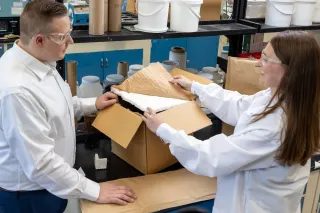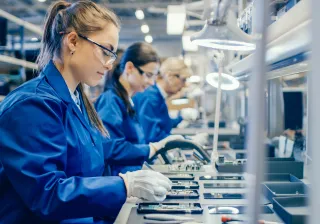Cellulose is an ideal raw material for electrical insulation components, but the manufacturing of products requires a considerable measure of craftsmanship. In the NOVUM project coordinated by VTT, the raw materials and manufacturing methods are developed side by side. One of the goals is an automated 3D printing line. The plan is also to make use of the solution, for example, in cruise ships and the automotive industry, in which the aim is to replace oil-based plastics with bio-based materials.
Cellulose is a popular insulation material in electrical power transformers because it is clean and capable of resisting high temperatures, and it remains firm in oil used in transformers for both insulation and cooling purposes. However, the raw material must be packaged into the moulds manually, and a variety of different moulds are required. The process also consumes energy and produces plenty of waste. With the current methods, the value of production is approximately EUR 1 billion a year.
The EU-funded NOVUM project, which lasts for 4.5 years, develops automated methods for the production of cellulose-based electrical insulation components and for other applications such as the automotive industry and cruise ships. The project started in October 2017, and the international research group has managed to limit the manufacturing methods to the most promising ones: 3D printing and foam forming. 3D printing offers efficiency as well as new freedom in design. Foam forming, on the other hand, makes it possible to save energy in the manufacturing process.
“Our goal is to build an automated production line in the premises of Brinter, NOVUM’s project partner in Finland, and test it in the relevant environment next autumn. In addition to efficiency, our goal is to save energy and material. Alongside the manufacturing methods, we are developing cellulose-based raw materials to suit the selected methods and applications the best possible way,” says Heli Kangas, Technology Manager from VTT.
3D printed parts for transformers, cars and cruise ships
As the research group works on developing cellulose-based materials and the manufacturing methods, it also investigates which other applications could be potential for the combination, in addition to transformers. A good starting point for the applications is the need to produce individual products or small series easily or to replace plastic parts with renewable material.
The automatic production line built in the project will be tested and validated with electrical insulation components and parts used in car and cruise ship interiors. The applications are of interest to Hitachi ABB Power Grids, manufacturer of electrical insulation components for its own transformers in Poland, Meyer Turku, a shipbuilding company and CRF, the research company of Fiat in Italy.
The NOVUM project also involves Brinter, developer of 3D printing technology in Finland, AGH University of Science and Technology in Poland, ABIS, an engineering company from Poland, JRS, supplier of renewable materials from Germany and Vertech Group, a sustainability expert from France.
Cellulose properties retained – thermal forming added
In addition to coordination work, VTT’s main focus in the project lies in material development. In order for cellulose to be 3D printable, it must be made thermoplastic, that is, pliable at an elevated temperature. Thermoplastic cellulose-based materials similar to oil-based plastics have previously been developed at VTT. However, for NOVUM project applications, it is important that the cellulose-based material also contains pure cellulose as much as possible as this is essential for insulation materials.
In addition to modifying the material to ensure compatibility with the manufacturing process, the material’s properties, such as its strength and heat resistance, are also adjusted in accordance with the application requirements. Irrespective of the exact composition of the material, it is already clear that the pieces produced can be ground and re-used as raw material on the same production line as many as eight times.







